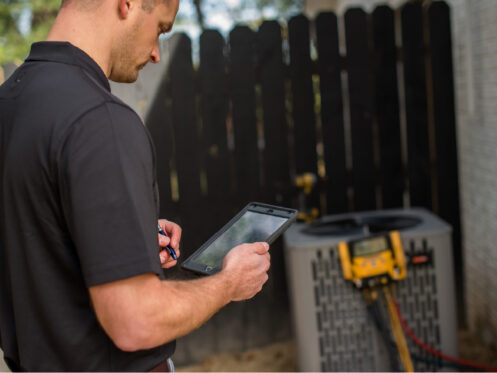Summer weather in Los Angeles, CA is temperate. Outside temperatures rarely climb above the mid-80s, and although relative humidity tends to be high along the coastline, the region is mostly dry throughout the foothills. Notwithstanding these things, you still need a functional air conditioner.
If your cooling equipment breaks down, the most vulnerable people in your household will suffer. More importantly, you won’t have a way to keep everyone safe during unexpected heat waves. The following is everything that you should do as soon as your AC stops working.
Implement Your Emergency Cooling Plan
During summer and without active home cooling, building interiors can become significantly hotter than the air outside. Thus, even when the mercury is relatively low, you can still have unsafe conditions indoors. If your air conditioner is no longer cooling your home, you’ll need to prevent more heat from entering the building and take advantage of your mechanical ventilation and fans. You can:
- Draw your curtains or blinds to prevent solar heat gains
- Turn your ceiling fans on
- Set up multiple standing fans
- Open your windows and doors to release heat
Make sure that your ceiling fans are set to rotate counterclockwise during the summer months. This will push a cooling breeze down and better support your standing fans.
Turn Off All Heat-Generating Appliances
As soon as your AC shuts down, turn off all heat-generating appliances. Ovens and powerful computers will raise your indoor temperature faster than your home can release heat. Until the necessary AC repairs are complete, your household can dine on cold cuts and salads or eat out, or you can use an outdoor grill if you have one.
Take Shelter Somewhere Else When Necessary
Some people are significantly more vulnerable to temperature extremes than others. While lacking a functional air conditioner during a heat wave is dangerous for everyone, high heat can take a major toll on aging adults, those with terminal illnesses, people with compromised immunity, and newborn infants. If you have a long wait ahead for emergency HVAC repairs, consider taking shelter somewhere else until your technician arrives. You can keep cool at a friend’s or family member’s home. You can also visit public spaces like libraries, museums, and movie theaters for both entertainment and free air conditioning.
Understand the Difference Between Troubleshooting and Repairing
There’s a big difference between troubleshooting a malfunctioning air conditioner and repairing it. All home cooling equipment comes with a manufacturer’s warranty. This agreement will pay for the replacement or repair of your AC if it ever breaks down due to defective parts, incorrect assembly, or all-around faulty workmanship. However, if you attempt to fix your AC yourself or prove noncompliant in other ways, you could accidentally void this agreement.
Fixing an air conditioner often involves removing housing or other covers, tampering with moving parts, and adjusting or replacing damaged components. Without the proper training, DIY repairs can cause more problems than they solve. To compare, troubleshooting your AC is simply optimizing its operating conditions.
Check for Airflow Obstructions
The first step in troubleshooting a broken AC is checking and changing its HVAC air filter. All of the air that enters your cooling system passes through this component. If your air filter has a thick, lint-like mat of debris, your AC will struggle to draw air through it. Common signs of dirty air filters include:
- Increased indoor humidity
- Warm air coming from HVAC air vents
- Short cycling
- Icing
- Overheating
You should also check for closed HVAC air vents and heavy buildups of debris behind vent covers or grilles. Closing HVAC air vents is never a good way to direct unwanted air away from a space. Vent closures create substantial buildups of pressure within HVAC ducting that cause undue stress and eventual shutdown. If you have a standard central HVAC system rather than a professionally zoned one, all of your air vents should be in a fully or partially open position.
It’s also a good idea to check the perimeter of your air conditioner’s outdoor condenser unit. This unit must have at least 2 feet of clearance on all sides at all times. Airflow obstructions at this component can inhibit heat release and lead to overheating and shutdown.
Check Your Thermostat’s Setting
It may be that your air conditioner isn’t working simply because your thermostat isn’t telling it to. If you haven’t had your AC professionally serviced in more than a year, it’s time to have your thermostat calibrated. Sometimes homeowners mistakenly set their ACs to “FAN” rather than “AUTO.” This causes fan motors to engage for constant airflow, but it never initiates a cooling cycle.
Address Icing
If your air conditioner’s evaporator coil is frosted over, turn your AC off and toggle your thermostat from “AUTO” to “FAN.” Blowing warm air over this component will accelerate defrosting. Although you may be able to turn your AC back on after all ice has melted, you’ll still need to address the underlying cause of icing. This may be a dirty air filter or a dirty evaporator coil. In most cases, coil icing indicates the need for professional AC maintenance.
Schedule Professional AC Repairs
After you’ve identified and eliminated airflow obstructions, schedule professional AC repairs. Attempting to fix your own air conditioner is dangerous. Not only can do-it-yourself (DIY) repairs result in the loss of your AC manufacturer’s warranty, but they also pose the risk of electrocution, electrical fires, and exposure to harmful refrigerants.
Scheduling AC repairs in a timely fashion prevents minor problems from spiraling out of control. It’s also the best way to protect your indoor air quality and your general health.
Know When to Replace Your AC Rather Than Fix It
Air conditioners typically last 15 to 20 years. If well-maintained, some newer models might last as long as 25 years. Before paying for an expensive AC repair, consider your cumulative repair bills, the increasing costs of running your air conditioner, and its age. Most ACs experience the majority of their problems within the last two to three years of their service lives. As such, if you opt for a repair now, you could be scheduling repairs again shortly. When air conditioners have already provided more than 15 years of service, replacing these units is often the most cost-effective decision.
Review Your Warranty Documents
Get your warranty documents out and determine whether or not you’re dealing with a covered issue. You should also check your home warranty agreement and your home insurance plan for applicable protections. Just as their name implies, manufacturer warranties pay for manufacturing-related issues. Home warranties pay for age and wear-related problems, and home insurance plans pay for damages caused by covered perils. If you’ve signed up for an HVAC preventative maintenance plan, you may even find that this agreement offers priority scheduling, discounted parts, or other benefits that can help right now.
We help homeowners in Los Angeles, CA optimize their home comfort with outstanding heating and cooling services. We also provide plumbing installation, maintenance, and repairs, indoor air quality improvements, and water treatment. If your air conditioner won’t turn on or no longer cools your home efficiently, get in touch with JW Plumbing, Heating and Air today to schedule an appointment.


